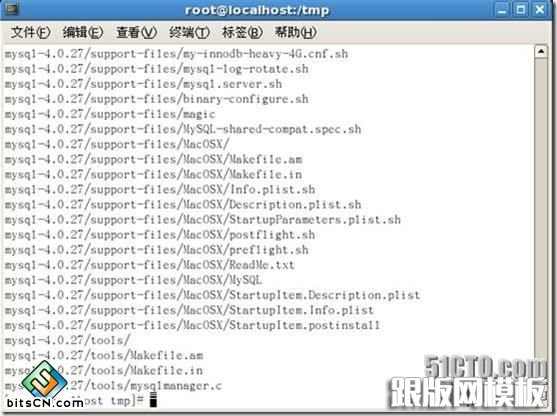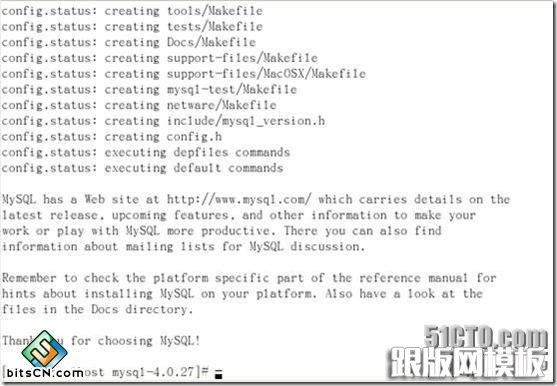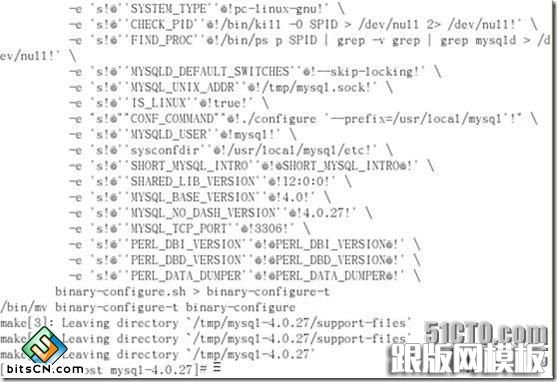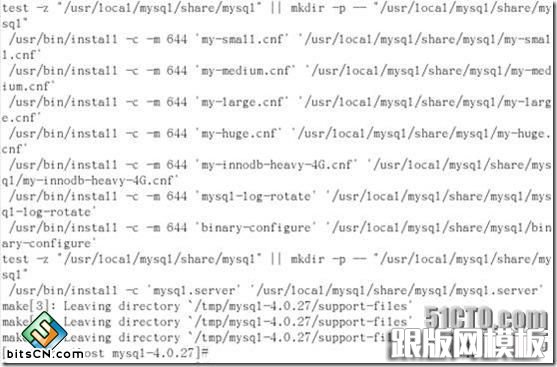linux 下 MySQL源码包的安装
实验环境 VMware 6.5.2 +redhatEnterprise 5 AS
实验目的 初步涉及源码包的安装,以简单实现其功能为目的,不对原理进行深层讨论
内核版本:

今天尝试安装MySQL的源码包 mysql-4.0.27.tar.gz
下载源码包 copy 到linux
[root@localhost ~]# cd /tmp
[root@localhost tmp]# ls
gconfd-laowu scim-helper-manager-socket-root
gconfd-root scim-panel-socket:0-laowu
keyring-8zb2FJ scim-panel-socket:0-root
linuxqq_v1.0.2-beta1_i386 scim-socket-frontend-root
linuxqq_v1.0.2-beta1_i386.tar.gz sealert.log
mapping-laowu ssh-lgCAZY2854
mapping-root virtual-root.Kez8K1
mysql-4.0.27.tar.gz VMwareDnD
orbit-root vmware-root
scim-bridge-0.3.0.lockfile-0@localhost:0.0 VMwareTools-7.8.4-126130.tar.gz
scim-bridge-0.3.0.socket-0@localhost:0.0 vmware-tools-distrib
[root@localhost tmp]#
[root@localhost tmp]# tar zxvf mysql-4.0.27.tar.gz
把源码包mysql-4.0.27.tar.gz 解压到当前目录

[root@localhost tmp]# cd mysql-4.0.27
进入mysql-4.0.27目录
[root@localhost mysql-4.0.27]# ls
acconfig.h configure.in INSTALL-SOURCE missing regex
acinclude.m4 COPYING isam mkinstalldirs scripts
aclocal.m4 dbug libmysql myisam sql
bdb depcomp libmysqld myisammrg sql-bench
BUILD Docs libmysql_r mysql-test strings
ChangeLog EXCEPTIONS-CLIENT ltconfig mysys support-files
client extra ltmain.sh netware tests
config.guess heap Makefile.am os2 tools
config.h.in include Makefile.in pstack vio
config.sub innobase man readline
configure install-sh merge README
[root@localhost mysql-4.0.27]#
INSTALL-SOURCE这里面有你需要的安装命令
添加mysql用户组
[root@localhost mysql-4.0.27]# groupadd mysql
You have mail in /var/spool/mail/root
添加mysql用户 并指定到mysql组中
[root@localhost mysql-4.0.27]# useradd -g mysql mysql
[root@localhost mysql-4.0.27]#
[root@localhost mysql-4.0.27]# echo "/* Linuxthreads */" >> /usr/include/pthread.h
你也可以直接运行下面这条命令直接执行编译准备,如果有错误,试试上面得阴影部分命令
[root@localhost mysql-4.0.27]# ./configure --prefix=/usr/local/mysql
编译前的准备,指定安装目录到/usr/local/mysql
试计算机性能不同,时间略有差别

[root@localhost mysql-4.0.27]# make
编译过程

[root@localhost mysql-4.0.27]# make install
编译安装 稍等

[root@localhost mysql-4.0.27]# cp support-files/my-medium.cnf /etc/my.cnf
复制mysql配置文件
[root@localhost mysql-4.0.27]# cd /usr/local/mysql
进入安装目录
[root@localhost mysql]# bin/mysql_install_db --user=mysql
使用mysql用户 初始化数据库
Preparing db table
Preparing host table
Preparing user table
Preparing func table
Preparing tables_priv table
Preparing columns_priv table
Installing all prepared tables
090501 15:30:45 /usr/local/mysql/libexec/mysqld: Shutdown Complete
To start mysqld at boot time you have to copy support-files/mysql.server
to the right place for your system
PLEASE REMEMBER TO SET A PASSWORD FOR THE MySQL root USER !
To do so, start the server, then issue the following commands:
/usr/local/mysql/bin/mysqladmin -u root password 'new-password'
/usr/local/mysql/bin/mysqladmin -u root -h localhost.localdomain password 'new-password'
See the manual for more instructions.
You can start the MySQL daemon with:
cd /usr/local/mysql ; /usr/local/mysql/bin/mysqld_safe &
You can test the MySQL daemon with the benchmarks in the 'sql-bench' directory:
cd sql-bench ; perl run-all-tests
Please report any problems with the /usr/local/mysql/bin/mysqlbug script!
The latest information about MySQL is available on the web at
[url]http://www.mysql.com[/url]
Support MySQL by buying support/licenses at [url]http://shop.mysql.com[/url]
[root@localhost mysql]#
[root@localhost mysql]# chown -R root .
改变当前目录的所有属主为root
-R 为递归(即其下所有的子文件的属主也随之改为root)
[root@localhost mysql]# chown -R mysql var
改变var的属主为mysql
[root@localhost mysql]# chgrp -R mysql .
改变当前目录的属组为mysql
[root@localhost mysql]#
[root@localhost mysql]# bin/mysqld_safe --user=mysql &
后台启动mysql服务 &为后台启动
[1] 17776
[root@localhost mysql]# Starting mysqld daemon with databases from /usr/local/mysql/var
[root@localhost mysql]#
[root@localhost mysql]# /usr/local/mysql/bin/mysql
登陆到mysql数据库
Welcome to the MySQL monitor. Commands end with ; or \g.
Your MySQL connection id is 1 to server version: 4.0.27-log
Type 'help;' or '\h' for help. Type '\c' to clear the buffer.
mysql>
mysql> show databases ;
基本的查看数据库命令
+----------+
| Database |
+----------+
| mysql |
| test |
+----------+
2 rows in set (0.00 sec)
mysql>
mysql> ?
查询命令
For the complete MySQL Manual online visit:
[url]http://www.mysql.com/documentation[/url]
For info on technical support from MySQL developers visit:
[url]http://www.mysql.com/support[/url]
For info on MySQL books, utilities, consultants, etc. visit:
[url]http://www.mysql.com/portal[/url]
List of all MySQL commands:
(Commands must appear first on line and end with ';')
help (\h) Display this help.
? (\?) Synonym for `help'.
clear (\c) Clear command.
connect (\r) Reconnect to the server. Optional arguments are db and host.
edit (\e) Edit command with $EDITOR.
ego (\G) Send command to mysql server, display result vertically.
exit (\q) Exit mysql. Same as quit.
go (\g) Send command to mysql server.
nopager (\n) Disable pager, print to stdout.
notee (\t) Don't write into outfile.
pager (\P) Set PAGER [to_pager]. Print the query results via PAGER.
print (\p) Print current command.
prompt (\R) Change your mysql prompt.
quit (\q) Quit mysql.
rehash (\#) Rebuild completion hash.
source (\.) Execute a SQL script file. Takes a file name as an argument.
status (\s) Get status information from the server.
system (\!) Execute a system shell command.
tee (\T) Set outfile [to_outfile]. Append everything into given outfile.
use (\u) Use another database. Takes database name as argument.
Connection id: 2 (Can be used with mysqladmin kill)
mysql> quit
Bye
[root@localhost mysql]#
退出数据库
